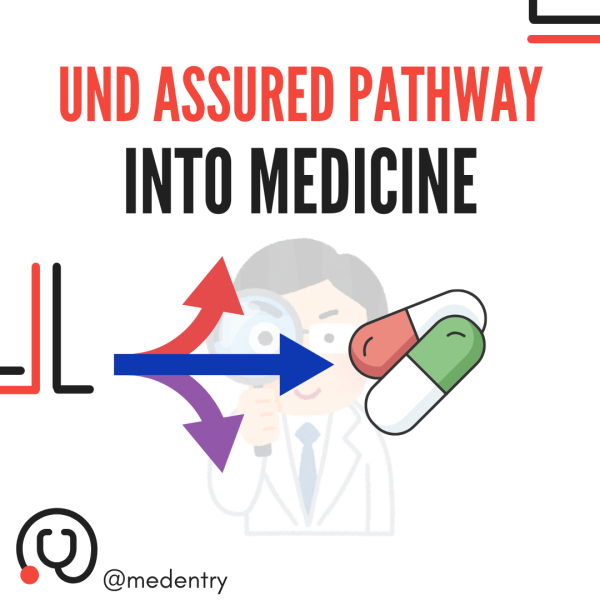Medicine at Notre Dame

10 months ago by Chris
Medicine at The University of Notre Dame Australia (UNDA) is a medical course which spans over the course of four years. Throughout the first two years of the postgraduate degree, students will focus on learning the foundations, with problem based learning, communication skills sessions, site visits and workshops. In the third and fourth year, students will start to engage in clinical placements.
Although up until now, places have only been made available to Australian and New Zealand citizens and residents, in 2025, 60 places will open up to International students.
Admission, much like any other medical school, is highly competitive, with UNDA using a combination of GPA, GAMSAT, Casper testing and interviews (depending on the specific pathway of entry).
This blog will cover two key entry pathways: the Assured Pathway and the Priority Pathway.
Assured Pathway
What is it?
The Assured Pathway into Medicine is a conditional offer into the Doctor of Medicine course upon completion of a Bachelor of Biomedical Science or Bachelor of Advanced Biomedical Science (Honours), either of which must be completed at the University of Notre Dame. It is conditional in the sense that students must meet a prescribed minimum GPA of 2.5 - a credit or distinction average, which for most successful applicants, would be very achievable.
Who can apply?
The Assured pathway at Notre Dame is reserved for school leavers, that is, students who have either completed their Year 12 studies in that year, or the year before. For example, for the 2025 admission, those who have completed their secondary studies and achieved an ATAR in either 2024 or 2025 can apply. (This means that those who have studied another course for one year, or have taken a gap year can still apply).
How many places are there?
This Pathway is new, having been established in 2023. From 2024, there are 40 places available nationally (20 in Fremantle and 20 in Sydney).
What are the cut off scores for admission?
Note: Reported scores are estimates made from the 2023 admission. As this program slowly gains greater recognition, these thresholds are bound to increase.
In order to be considered competitive for an interview, students should aim to achieve a score of 3100 in the UCAT. Although it is officially unconfirmed at this stage if Situational Judgement holds any weighting, it is speculated to hold some effect.
A competitive ATAR for this program is estimated to be around 98.5 or higher.
Why is UND offering the assured pathway now?
UND was previously a graduate medical school. However, all graduate entry medical programs have belatedly and begrudgingly realised that the most able and motivated students tend to choose the school leaver entry pathway, rather than the graduate entry pathway.
In order to be able to compete and attract a fraction of such students, graduate entry programs such as UND offer the next best thing: which they call ‘assured entry’ or ‘guaranteed entry’.
Applying
Applicants can apply to this program by placing the Assured Pathway course onto their UAC preferences. Be sure to note that there are multiple Assured Pathway preferences available, with applicants able to apply for the normal Bachelor of Biomedical Science, or for honours. Additionally, there are CSP (Commonwealth Supported Places) and CBF (Combined Fee Places) available for both the non-honours and honours degrees.
Admission
There are three components for entry into the assured pathway at UND, much like other undergraduate medicine programs: the UCAT, ATAR and a medical interview. The exact weighting of all components is yet to be confirmed, but all are considered for admission.
Priority Pathway
The University of Notre Dame also offers the Priority Entry Pathway. In this pathway, students study the Bachelor of Biomedical Science at the University of Notre Dame, before attempting to enter into the postgraduate medical course. The following criteria are taken into account: GPA, GAMSAT, Casper test and an interview. Students can enter this Pathway both in Sydney and Fremantle.
By entering through the Priority Pathway, instead of competing with applicants from other courses or universities, those who enter the Priority Pathway, have alleged “lower” thresholds needed in order to enter the Doctor of Medicine program. It is important to note that in this pathway, a certain number of places are allocated each year into the medical school, with those making the threshold then competing for a place.
In 2023, the intake into the postgraduate course held an average of a 6.70 GPA and GAMSAT score of 66.
Further details regarding entry into UND is provided in MedEntry’s Interview Training packages.
Guidance and advice on medical schools preferencing can be found in this blog:
https://www.medentry.edu.au/blog/medical-school-preferencing


